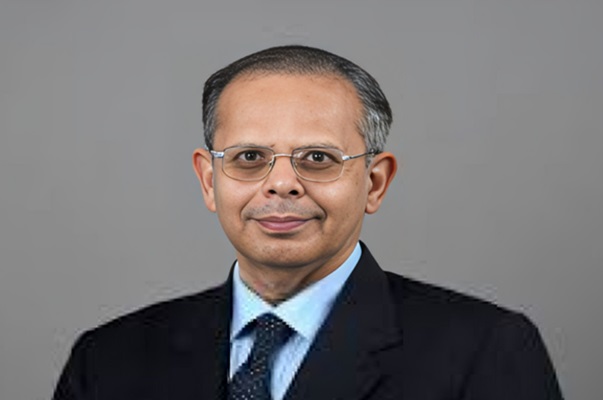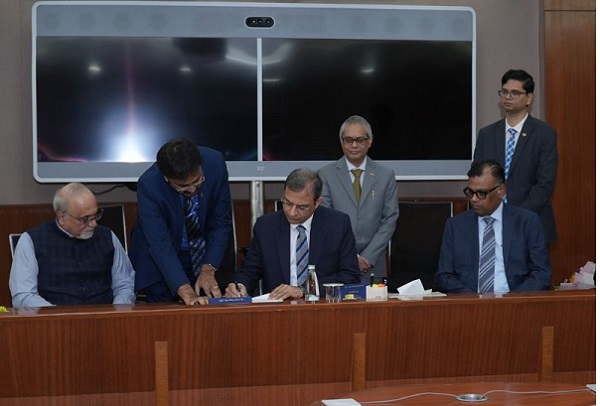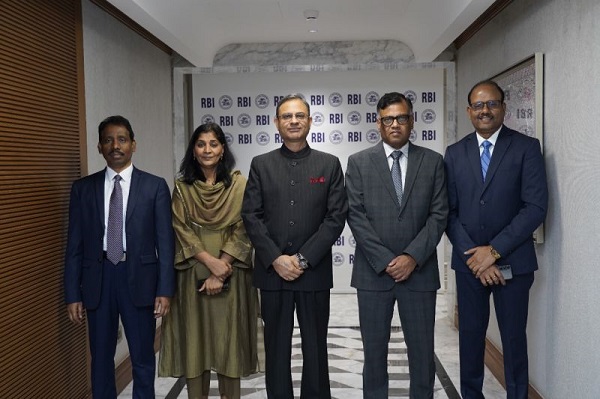.png)
RBI Has Ample Room To Cut Rates Further, Says MPC’s Saugata Bhattacharya
RBI models showed repo rate at 5.1-5.7%. The MPC member says he leans more towards the lower end of that range.


Rajesh Mahapatra, ex-Editor of PTI, has deep experience in political and economic journalism, shaping media coverage of key events.
May 2, 2025 at 4:22 AM IST
When Saugata Bhattacharya says there is “ample room” for the Reserve Bank of India to cut interest rates, he means it quite literally.
Citing RBI's internal modelling, the external Monetary Policy Committee member says the repo rate could fall to a range of 5.1% to 5.7% without fuelling inflation, adding that he personally leans toward the lower end of that band.
With inflation expected to hover near the central bank’s 4% target and global growth downgrades gaining pace, Bhattacharya believes the macro backdrop warrants further policy support.
If anything, the banking system may get ahead of the curve.
Short-term market rates have already tracked below the policy rate, and Bhattacharya, a former chief economist of Axis Bank, sees merit in banks and non-banks front-loading lending rate cuts.
With over 60% of loans now linked to external benchmarks that adjust directly with the repo rate, transmission is poised to be quicker than in past cycles. MSMEs and retail borrowers, he argues, stand to benefit most from accelerated pass-through.
Bhattacharya’s support for the April stance shift—to move from a neutral to an accommodative bias—did not come without internal debate. Initially concerned about the potential loss of flexibility, he changed his position after the Governor clarified that an accommodative stance still permits a pause, if warranted. That reassurance, combined with a low probability of needing to hike rates, tilted his view toward supporting the move.
Importantly, Bhattacharya does not see the current easing cycle as a mechanical sequence of cuts. Further action, he maintains, will be data-dependent. But he is unequivocal about direction: rates are heading lower, whether gradually or otherwise. Structural disinflation, weak private investment, and subdued global trade all point toward the need for monetary accommodation.
Transmission, meanwhile, may be swifter than the two-quarter lag often seen in earlier cycles. With surplus liquidity expected to be maintained at around 1% of NDTL and the RBI using multiple tools to signal its intent, Bhattacharya expects the impact of further repo rate cuts to show up in retail and MSME borrowing costs well before the festive season.
Here are the edited excerpts of his interview.
Q: What in your view was the biggest trigger for the repo rate cut?
A: Let me begin by reiterating that the views I express are entirely personal and not representative of the MPC’s deliberations.
Now, to your question—the key reason for cutting the policy repo rate from 6.25% to 6% in April, which was the second consecutive reduction after February, was a clear and growing comfort with the inflation trajectory. The data available to us, along with the Reserve Bank’s internal forecasts, strongly suggest that consumer price inflation for 2025-26 will average around 4%. In fact, there’s a real possibility it could turn out to be even lower.
Multiple macroeconomic indicators reinforce this view. Global crude oil prices are likely to remain soft, with current averages expected to stay below the earlier assumption of $70 per barrel. Similarly, industrial metal prices—another key input cost—have been under pressure, largely due to China’s continuing growth deceleration. This slowdown has tempered global demand, and the IMF’s latest forecast also signals weaker global output. All of this has a disinflationary effect on input prices.
On the food front too, we have reasons to be cautiously optimistic. El Niño conditions have now moved to neutral, and the early outlook for the monsoon suggests a normal rainfall pattern. If that plays out, agricultural supply conditions will support food price stability, which is crucial for India’s inflation profile.
Of course, there are risks to this relatively benign outlook. Geopolitical frictions—particularly the United States’ new tariff measures and the potential for retaliatory responses—could cause short-term supply chain disruptions. These may introduce some price pressures, but we view them as transient.
Over the medium term, the deflationary impulse from slower global trade and weaker growth is likely to dominate.
What this means in practical terms is that the RBI now has more monetary policy space than before. Growth has clearly moderated—both the Reserve Bank and the IMF have revised India’s growth forecasts downward—and global demand remains tepid. In this environment, inflation is not the constraint. The challenge is supporting growth without risking mac5.roeconomic stability. That’s precisely the window of opportunity that informed our rate decision.
Q: Would it be fair to infer then that the overall easing in global prices could more than offset any inflation imported into the domestic economy because of the tariff war? Is that the MPC’s implicit assessment?
A: That’s a fair reading, and you’ve captured the underlying logic succinctly. Whatever residual price pressures may surface domestically—whether from supply bottlenecks, sector-specific demand, or tariff-linked disruptions—the dominant influence on inflation in the near term is likely to come from the global side. And those signals are unmistakably disinflationary.
Commodity prices are subdued, global demand is weakening, and shipping costs have stabilised after the earlier spikes. When you put that together with an expected normal monsoon and softer food inflation, the aggregate pressure on prices appears quite manageable.
There is, however, one additional factor I should mention: the risk of dumping. Some countries, in response to slowing external demand, may export goods at prices below cost—essentially pushing deflation through trade channels. While this is certainly not desirable from a domestic output or competitiveness standpoint, it does exert further downward pressure on domestic prices.
The government is aware of this and is actively monitoring trade flows. But from the perspective of monetary policy, the net effect of these developments strengthens the case for easing. It’s a situation where inflation remains contained—even with the external noise—giving us greater headroom to support growth.
Q: But they could also have an adverse impact on growth, won’t they?
A: Absolutely, they are likely to have an adverse impact on growth. Given the growth-inflation balance—as a summary of all the factors I mentioned—it clearly leans towards the need to support growth, especially when price pressures are expected to remain moderate.
Q: In the minutes of the MPC meeting, one noticed that while there was unanimity on the rate cut, there seemed to be some initial reservations from your side about shifting the stance from “neutral” to “accommodative”. You eventually came on board after certain clarifications. Could you take us through that?
A: First, let me clarify that the decision to change the stance was also unanimous. While we had committed not to vote on the stance this time, there was full agreement on moving to an accommodative position.
My initial hesitation stemmed from the idea that a neutral stance gives us flexibility—to raise rates, hold, or cut—depending on how conditions evolve. At that point, I believed that keeping all options open had merit. But looking at the growth-inflation balance, the likelihood of needing to raise rates—not just immediately, but even in the foreseeable future—seemed extremely low. The conditions that might warrant a rate hike were simply not present.
During our discussions, and particularly in the Governor’s post-policy statement on April 9, two paragraphs were devoted to explaining the shift in stance. It became very clear that an accommodative stance did not preclude the possibility of a pause, should circumstances require it. That was reassuring for me.
We’ve seen several central banks—the Bank of England, the Reserve Bank of Australia, among others—adopt accommodative stances while still retaining the flexibility to pause. That made sense in the current environment, given the sheer uncertainty in the evolving macroeconomic landscape.
If the growth-inflation trajectory unfolds as expected, the only scenario that might call for a pause is stress on the external front. But even there, the risks currently appear limited. The dollar has weakened against major currencies, and China’s yuan—contrary to fears—is actually showing signs of strengthening. So, the external currency environment, too, doesn’t suggest a need to hold back.
In sum, the accommodative stance gives the MPC—and me personally—the space to act or pause as needed. That flexibility, combined with the direction of travel being clearly toward lower interest rates, made it the right time to support the shift in stance.
Q: When you were expressing these concerns, were they more about the first-order impact on trade flows or the second-order effects on investment and sentiment?
A: There are multiple factors at play on the external front. Even before the meeting, the WTO had published a revised forecast showing lower trade growth. Since then, several organisations—including the IMF and the WTO—have further downgraded global trade growth, with the WTO cutting its forecast by nearly half a percentage point. Global trade is now expected to contract in 2025.
That will undoubtedly have spillover effects on India. The IMF has also revised down global growth projections, which adds to the pressure. All of this suggests some weakening of growth momentum for us as well.
From a trade perspective, it's difficult to predict how the current account or trade deficit will evolve. On the external side, there is the added concern of dumping, which could lead to a rise in imports. The government has indicated its willingness to impose duties to curb such unwarranted inflows, but pressures from imports may still persist.
On the domestic front, it’s equally uncertain. If growth slows, how households respond will be critical. Will they reduce consumption? Will they dip into savings to maintain spending levels? Will consumption remain stable even if import volumes fall? These behavioural responses are hard to forecast.
Meanwhile, investment activity is also likely to slow. Given the prevailing uncertainty, the private sector is likely to hold back—certainly not invest at the pace it has in the past. Financing this investment may also prove challenging. FDI flows—whether into equities or other segments—could be lower. Stock market-linked flows may soften as well.
Remittances, which are part of the current account, also face risks. If growth slows in developed economies such as the US and Europe, from where India receives a substantial volume of remittances, inflows could decline. In the Gulf region too, where lower oil prices are expected, remittance volumes might drop.
So, there are many moving parts to the external balance, all of which contribute to the broader uncertainty. Taken together, they build the case for a slowdown—both from external and domestic channels.
Q: Now that the stance has shifted from neutral to accommodative, how do you see its role evolving in the MPC’s communication strategy? Is there scope for a more explicit forward guidance framework within the RBI?
A: The stance itself is essentially a form of forward guidance. An accommodative stance signals, as I’ve said earlier, that the bias of future action is towards reducing interest rates. How far, and at what pace, will depend entirely on incoming data. In my view, these decisions will continue to be made on a meeting-to-meeting basis, guided by prevailing macroeconomic conditions.
If our current forecasts hold—that is, if growth slows and inflation remains moderate—then there is ample monetary policy space to cut rates further. That said, at no point do we expect interest rates, including the policy rate and the broader rate structure, to fall so low that demand overshoots and pushes the economy close to potential output, which could risk stoking inflation. I believe we’re still quite some distance from that scenario.
In fact, several analytical studies by the Reserve Bank of India indicate that the repo rate could range between 5.1% and 5.7%, depending on how the economy evolves. Given the global supply chain dislocations and the broader context, I would personally lean toward the lower end of that range.
At this point, there is strong evidence that monetary policy—alongside fiscal, trade, industrial, and agricultural policies—needs to play an active role in supporting growth. This is especially relevant through the credit channel. MSMEs, in particular, are bearing relatively high borrowing costs, and that needs to come down. Lower rates for this segment could meaningfully stimulate activity. So yes, I do believe there is ample space for further rate cuts at this stage.
Q: Now let’s move to the other side of the story—beyond rate cuts. Liquidity is the other big dimension that determines the effectiveness of monetary policy in supporting growth. What’s your assessment there? Do you see a risk of transmission breaking down if markets front-run the easing cycle too aggressively?
A: No, I don’t see that as a risk. While liquidity is not directly in the remit of the Monetary Policy Committee, it plays a very important role in operationalising monetary policy. After all, monetary policy is ultimately about transmission into interest rates. If the policy repo rate is being cut but it doesn’t affect lending or deposit rates, then there’s clearly a breakdown somewhere in the transmission mechanism.
On that front, the Governor has been very clear. In his previous post-policy interaction with the media, he stated that he is comfortable with a liquidity surplus of around 1% of NDTL—that is, Net Demand and Time Liabilities, which effectively means total bank deposits. The RBI is using multiple tools to communicate this position to markets: OMOs, variable rate reverse repos, FX swaps, and other instruments. Through all these, the RBI is signalling that it will ensure there is sufficient liquidity in the system—whatever is needed.
So, if as you say, markets or banks anticipate easing and start reducing lending rates even before further repo rate cuts, that’s actually a good outcome. A bit of front-running in terms of deposit and lending rate adjustments would help speed up transmission. If banks, NBFCs, and other financial intermediaries lower rates ahead of policy moves, it reinforces the intended direction of policy.
We’ve already seen short-term interest rates—like the call rate, three-day, and seven-day money—fall towards the SDF, which is 25 basis points below the repo rate. Those rates have now begun moving closer to the repo again, but for a time they had indeed dropped. That lower cost of short-term borrowing helps banks reduce their cost of funds, which supports faster lending rate cuts.
Also worth noting is that about 60–62% of total bank loans are now linked to the external benchmark lending rate, which is tied directly to the repo rate. So, when the repo rate is cut, lending rates on those loans adjust almost immediately—often within days—by the same quantum, say 35 basis points or more.
The remaining loans are priced based on MCLR, or the marginal cost of funds-based lending rate. RBI’s liquidity management is indirectly signalling to banks that they now have the headroom to reduce MCLR as well. That still covers roughly 90% of all loans in the system, so it’s quite significant.
Earlier, the RBI’s Deputy Governor had indicated that full transmission typically takes around two quarters. My own sense is that this time, the process will be considerably faster. Given the liquidity support and the extent of EBLR-linked loans, I expect transmission of repo rate cuts into lending rates to happen more quickly in this cycle.
Q: So, by the time the festive season arrives, can one expect a meaningful decline in home loan rates, auto loan rates, or consumption loan rates?
A: I remain completely confident about that. Of course, this is contingent on the growth-inflation balance staying as expected—growth continuing to slow or remain moderate. If that holds, as I mentioned earlier, there is ample space for further rate cuts. And once those cuts happen, they will translate very quickly into lower rates for home loans and other retail credit.
Remember, all retail loans—whether home, personal, or auto—are now linked to the external benchmark lending rate. The same applies to MSME loans. So, if the repo rate is reduced by, say, 50 or 100 basis points—though we can’t put a number on it at this stage—that reduction will be passed on almost instantly to borrowers.
That hasn’t always been the case in the past. And that’s exactly why the EBLR framework was introduced. Under the earlier MCLR system, the transmission of policy rate cuts into lending rates was often delayed. It took time for rate changes to be reflected in actual loan pricing. EBLR was designed to address that issue, and it has made a significant difference in speeding up the process.
Q: I’m asking you this not in your capacity as an MPC member, but as an economist. How do you view the RBI’s current liquidity management? Is it calibrated more towards ensuring transmission or ensuring financial stability? Are these objectives in conflict, or can they converge?
A: I don’t think there is any major concern on that front. Yes, there’s always the chance of an isolated financial accident, but the probability of that happening right now is very, very low.
I understand the concern—that with surplus liquidity in the system, banks might push retail lending too aggressively. If underwriting or risk management standards slip, that could lead to problems. But again, the likelihood of that, in my view, is minimal.
The real intent behind maintaining a liquidity surplus at this stage is to aid transmission. If you look back at previous easing cycles, you’ll see that a surplus liquidity condition is almost a prerequisite when the interest rate cycle is turning down. Without that, repo rate cuts won’t effectively translate into lower lending and deposit rates.
That said, there is one area that does require some balancing—from the depositor’s perspective. As banks reduce lending rates, they also tend to cut deposit rates. That can hurt savers, especially retirees who rely on interest income from fixed deposits. It’s a real concern for that segment, and even for others who depend on deposit earnings.
But from a lending perspective, the case for surplus liquidity is stronger—especially for MSMEs. If we are to meaningfully stimulate growth, credit must be available to these businesses at lower interest rates. So overall, I would say a surplus liquidity condition is both necessary and appropriate at this stage of the rate cut cycle.
Q: Lastly, I wanted to bring you to the role the real effective exchange rate plays in the growth–inflation trade-off. How do you see it?
A: I think exchange rates—particularly the real effective exchange rate—are complex enough to merit two more episodes of your show.
Simply put, a weaker rupee is, in theory, supposed to enhance the competitiveness of Indian exports. It should help our exporters compete more effectively with peers from ASEAN countries like Vietnam, Cambodia, and Thailand.
But in practice, it’s much more complicated. When the rupee weakens, other currencies—like the Vietnamese dong, Cambodian riel, or Thai baht—might also depreciate. So, the relative advantage can quickly erode. That’s why the drivers behind a weaker rupee matter a great deal.
India is not in the same situation as it was in 2013, when we were grouped among the so-called "fragile five." Our macroeconomic fundamentals today are far more resilient. We are not starting from a position of weakness. The current rupee movement must be understood in the context of broader shifts—such as dollar strength or changes in the Chinese yuan.
The real effective exchange rate, as you mentioned, is not just about the rupee versus the dollar. It’s measured against a basket of currencies—the euro, pound, yuan, Swiss franc, krona, and others. So, if the dollar strengthens, most other currencies—including the rupee—may appear weaker in relative terms.
Now, while a weaker rupee against the dollar can boost export competitiveness, it also has costs. For one, companies that have borrowed via external commercial borrowings will face higher repayment costs. And more importantly, a weaker currency raises the price of imports, including critical ones like oil. That channels imported inflation into the economy.
So ultimately, the trade-off is delicate. You might gain a bit on exports, but if the rupee weakens too much, you risk higher inflation, costlier debt servicing, and erosion of real incomes. Managing this balance will be crucial going forward.



